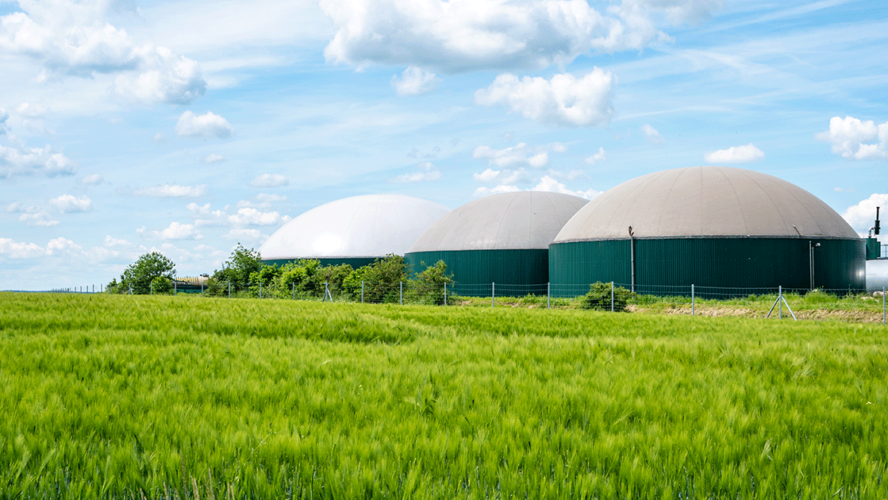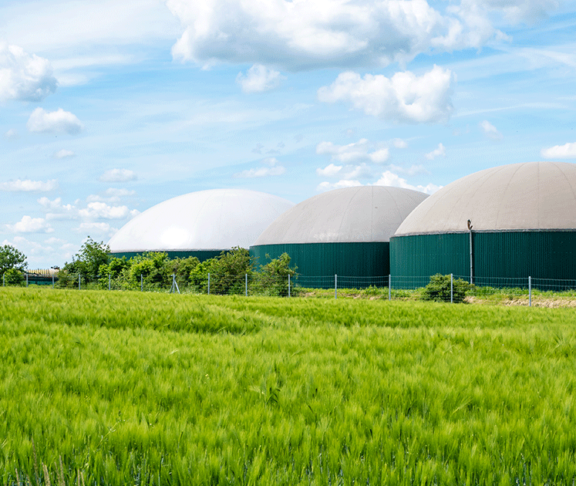Biogas and renewable natural gas (RNG) are a proven climate solution, with nearly 300 projects across Canada already preventing more than eight Mt CO2e of greenhouse gas (GHG) emissions (equal to 1,780,242 gasoline-powered passenger vehicles!) from reaching the atmosphere every year. They also produce a total of 22 petajoules (PJ) of low-carbon energy – the equivalent of 14 large hydro dams or 440,000,000 m3 of solar panels.
Unfortunately, Canada is only tapping about 13% of its available biogas & RNG potential. With the right mix of policy and investment, this untouched capacity could provide a significant boost to the country’s climate goals. But what is biogas & RNG?
Production begins with the treatment of residuals from agricultural, municipal and industrial organics – everything from livestock manure to household green bin materials to restaurant food leftovers. These materials are collected and broken down through a process called anaerobic digestion, which is the breakdown of organic materials without the presence of oxygen. Biogas captured during this process can then be used to heat, generate electricity, or be upgraded into RNG and used in existing natural gas infrastructure.
Anaerobic digestion facilities also prevent methane (a dangerous GHG) from reaching the atmosphere. In Canada, methane emissions from landfills accounted for 3.1% of the country’s GHGs in 2019.1 Meanwhile, agricultural waste, including from animal manure and crop residues, is responsible for 4% of Canada’s methane emissions.
Unfortunately, Canada’s waste potential is being well…wasted. A 2020 study commissioned by Natural Resources Canada calculates that less than one third of easily available landfill gas is being utilized.2 And it’s estimated that we’re tapping as little as 1.3% of available agricultural biogas & RNG feedstock.
So how can biogas & RNG help move Canada along the path to net zero? Here are just a few of the benefits.
1. Clean Energy Production
When biogas & RNG systems recover methane emissions, they not only destroy it, it’s also put to use, resulting in the production of low-carbon energy. This energy then replaces fossil fuel-based energy for electricity, heating and transportation systems, resulting in additional GHG reductions.
2. Economic Growth
The industry is already delivering economic benefits by driving private investment, generating green jobs, and spurring new businesses in almost every part of the country. With the right policies in place, in a best-case scenario biogas & RNG could:
- Create 19,900 full time equivalent jobs by 2030, the vast majority (96%) of which are related to biogas & RNG development in the agriculture sector.
- Lead to almost $2.2 billion in private investment, mostly originating from development in the agriculture sector. It also means more than $5 billion in annual GDP compared with just $1.2 billion under current renewable energy policies.
3. GHG and Methane Abatement
Biogas & RNG projects could cut more than 16.5% of Canada’s current methane emissions all on their own. When added to the targeted cuts from the oil and gas sector, biogas & RNG could help Canada achieve a 44.5% reduction in total methane emissions.
In 2021, Canada formally ratcheted up its initial 2030 GHG reduction goals from 30% to 40-45%. The right mix of policies could allow biogas & RNG to deliver 26.7 Mt CO2e in emissions reduction by 2030. This would provide a critical building block in filling the 66 Mt CO2e gap between Canada’s 2030 goals and what current climate plans are able to deliver.
Citations
1 . Government of Canada, (2021). National Inventory Report 1990–2019: Greenhouse gas sources and sinks in Canada – Canada’s submission to the United Nations Framework Convention on Climate Change, Part 2.
2 . Stephen J, et al, (2020). Renewable Natural Gas (Biomethane) Feedstock Potential in Canada. Torchlight BioResources.


